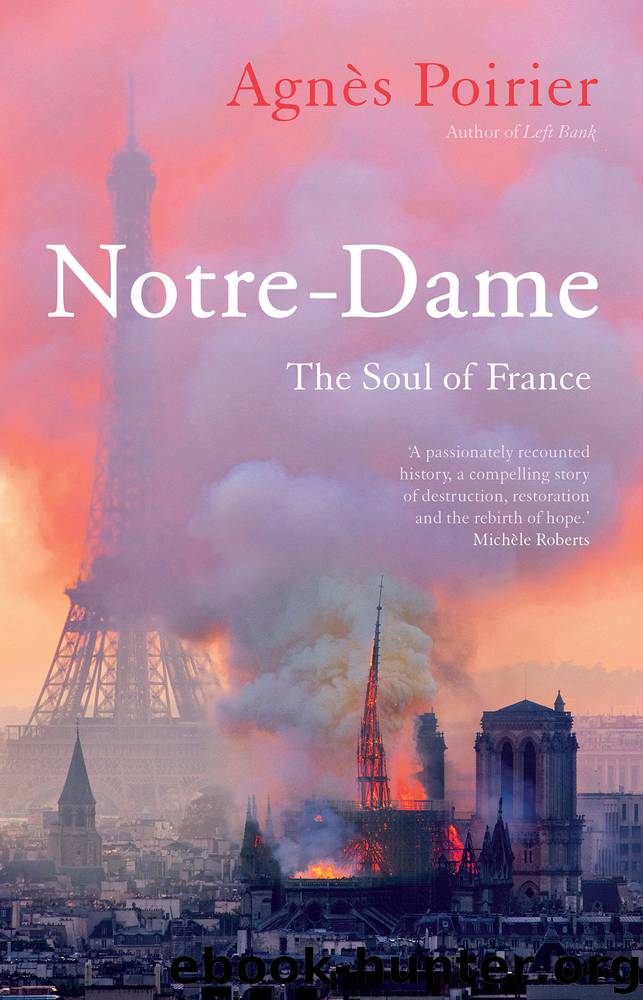Notre-Dame by Agnès Poirier

Author:Agnès Poirier [Poirier, Agnès]
Language: eng
Format: epub
ISBN: 9781786078001
Publisher: Oneworld Publications
Published: 2020-03-03T00:00:00+00:00
Each face, each stone of the venerable monument is a page not only in the history of France, but also in the history of science and art. Thus [. . .] while the little Porte-Rouge goes almost to the limits of fifteenth-century Gothic delicacy, the nave pillars, by their volume and weightiness, go back to the Carolingian abbey of Saint-Germain-des-Prés. Anyone would think that there were six centuries between that door and those pillars. [. . .] This central, generative church is a kind of chimera among the old churches of Paris; it has the head of one, the limbs of another, the rear of a third; something of all of them.
The second was because Notre-Dame was the people’s cathedral, making one feel that ‘architecture’s greatest productions are not so much the works of individuals as of societies; the fruit of whole peoples in labour rather than the inspiration of men of genius; the deposit left by a nation; the accumulation of centuries’.
Hugo’s novel heralded the resurrection of medieval architecture, soon spearheaded by the young, self-taught architect Eugène Viollet-le-Duc. Hired in 1834 by the newly created Department of Historic Monuments, Viollet-le-Duc, a rebel against the academies, also belonged to those lovers of old stones who tirelessly campaigned to restore and treat medieval monuments with dignity. If Victor Hugo saved Notre-Dame with his book, Viollet-le-Duc would soon lead her restoration.
The success of Notre-Dame de Paris was manifold. Having achieved its aim of saving Paris’s cathedral from certain death, it quickly grew into one of the first worldwide multimedia phenomena. The novel’s characters and the cathedral started appearing everywhere: on plates, thermometers, ashtrays, figurines, clocks, posters, cheap prints and lithographs, among many other objects. A couple of months after its publication, Hugo reluctantly agreed to its adaptation for the opera. In fact, since 1832 it has been produced ten times on stage for theatre and ballet, a dozen times as a musical and another ten times on the big screen since the beginning of cinema – its most notable film versions being with Charles Laughton and Maureen O’Hara as Quasimodo and Esmeralda in 1939, and Anthony Quinn and Gina Lollobrigida in 1956. The 1996 Disney animation film The Hunchback of Notre-Dame guaranteed the passing of the torch to future generations, which may explain why Victor Hugo’s novel has even provided hit soundtracks for Céline Dion and the setting for video games such as Assassin’s Creed Unity.
The French often turn to literature in the wake of national catastrophes. After the Charlie Hebdo attacks in January 2015, sales of Voltaire’s Traité sur la tolérance (Treatise on Tolerance, 1763), a pamphlet against religious fanaticism, sky-rocketed. After the 13 November 2015 attacks in Paris which left more than 130 people dead and 400 injured, Ernest Hemingway’s A Moveable Feast topped the best-seller chart for months. The book’s celebration of Paris, its insouciance and joy, spoke to millions of French people traumatized by the terrorist attacks. In the weeks that followed the fire of 15 April 2019,
Download
This site does not store any files on its server. We only index and link to content provided by other sites. Please contact the content providers to delete copyright contents if any and email us, we'll remove relevant links or contents immediately.
| Africa | Americas |
| Arctic & Antarctica | Asia |
| Australia & Oceania | Europe |
| Middle East | Russia |
| United States | World |
| Ancient Civilizations | Military |
| Historical Study & Educational Resources |
Underground: A Human History of the Worlds Beneath Our Feet by Will Hunt(12026)
Sapiens by Yuval Noah Harari(5294)
Navigation and Map Reading by K Andrew(5111)
The Sympathizer by Viet Thanh Nguyen(4307)
Barron's AP Biology by Goldberg M.S. Deborah T(4100)
5 Steps to a 5 AP U.S. History, 2010-2011 Edition (5 Steps to a 5 on the Advanced Placement Examinations Series) by Armstrong Stephen(3690)
Three Women by Lisa Taddeo(3355)
Water by Ian Miller(3129)
The Comedians: Drunks, Thieves, Scoundrels, and the History of American Comedy by Nesteroff Kliph(3040)
Drugs Unlimited by Mike Power(2545)
A Short History of Drunkenness by Forsyth Mark(2234)
DarkMarket by Misha Glenny(2161)
The House of Government by Slezkine Yuri(2159)
And the Band Played On by Randy Shilts(2131)
The Library Book by Susan Orlean(2042)
Revived (Cat Patrick) by Cat Patrick(1963)
The Woman Who Smashed Codes by Jason Fagone(1929)
Birth by Tina Cassidy(1864)
The Absolutely True Diary of a Part-Time Indian by Sherman Alexie(1859)
